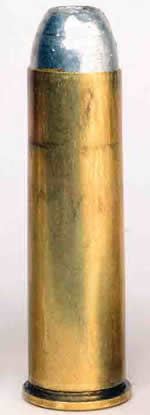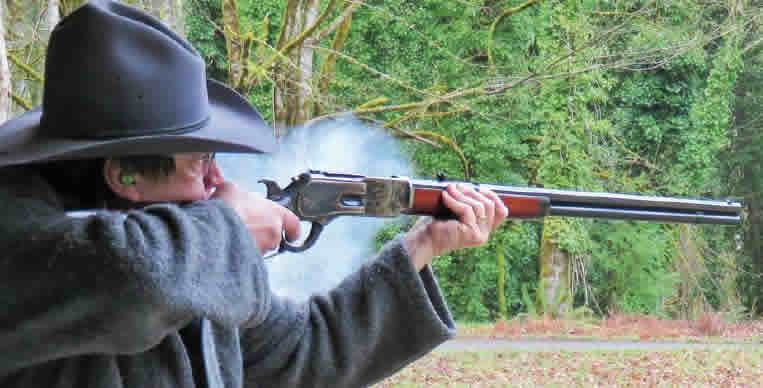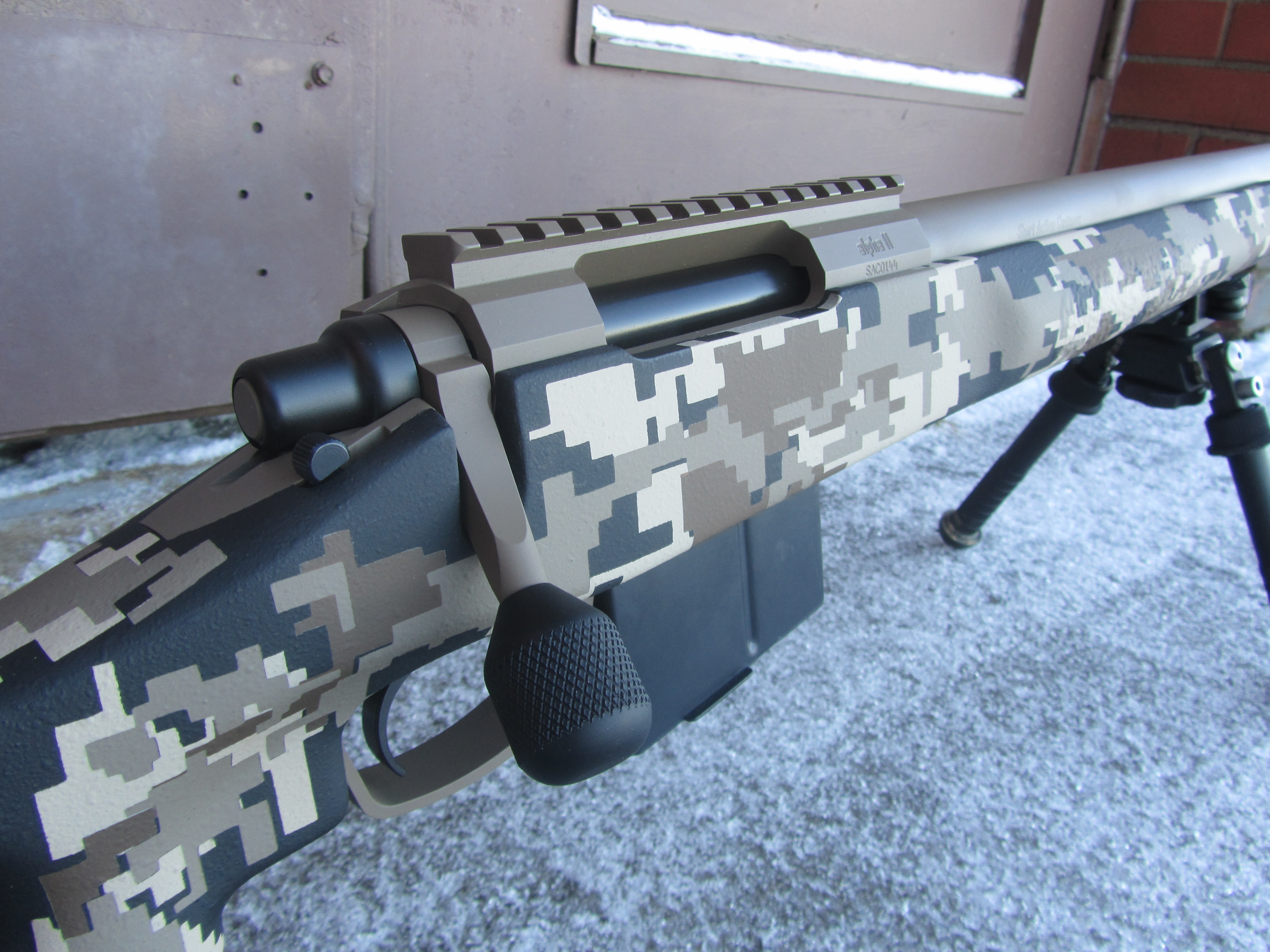1876 Winchester

Our man with the black powder on his hands tests loads for the ‘new’ .50-95 1876 Winchester manufactured by Uberti.
One big difference between the old and new .50-95-caliber rifles is that the original Winchesters from 1879 had a rate of twist in their barrels of one turn in 60 inches. That was for the very short 300- or 312-grain .50-caliber bullets. Today’s copies of those guns, namely the Uberti version of the old Winchester Model 1876, have barrels with one turn in 48 inches. That simply means the new .50-95s will perform with slightly heavier bullets.

When it was introduced, the .50-95 Winchester was the largest member in the line-up of cartridges for the repeating Model 1876. All of the cartridges chambered in the 1876 Winchester were considered short-range rounds when comparing them to the mid range and long range cartridges that were available only in single-shot rifles at that time.
And the .50-95 was an express cartridge, shooting a rather lightweight bullet at a high velocity, listed at 1,556.8 feet per second, making it a powerful hunting rifle for thin-skinned game within, let’s say, 200 yards.
Mike Venturino included the .50-95 cartridge in Shooting Lever Guns of the Old West (2010), which is an excellent book. In the section on cartridge reloading, he gave the specs for loads with both Goex FFg powder and the fine Cartridge powder, which is no longer available.
We might say that Mike wrote about the .50-95 almost a decade too soon, because there are now some important new “ingredients” that were not previously available.

THE UBERTI 1876 IN .50-95 has a 28-inch barrel, the same length as their other 1876 calibers. Along with a different twist rate, the groove diameter of the barrels on the new guns is a touch wider than the old Winchesters.
The rifle shot for this update had a barrel with a .514-inch groove diameter, and Mike said the original he shot with had a .509-inch groove diameter. These are simply little differences we should know about in advance of preparing any “special diet” for the newer .50-95.
Another “new thing” that wasn’t available when Mike did his loading and shooting for his book with the .50-95 was Jamison’s brass or ammunition.
Jamison, now a division of Captech International (visit captechintl.com/products), offers both new brass and loaded ammo for all of the Winchester Model 1876 calibers, which includes the .50-95.
Jamison ammo uses a 350-grain lead bullet over just enough smokeless powder to give it an advertised velocity of 1,300 feet per second. That’s a bit of a “cowboy” load and, of course, it was the Cowboy Action shooters who made the old lever guns popular enough for this new ammo to be made.
All of the loading and shooting done for this update was done with either Jamison’s loaded ammunition or new Jamison brass. The remaining ingredient that wasn’t available 10 years ago for use in the .50-95 was Goex’s Olde Eynsford powders.
A decade ago Goex was offering cartridge powder, and Mike’s chapter on the .50-95 did show one load using it. And Olde Eynsford is available in four different grades for better fine-tuning of black powder loads. In the following information, two of the Olde Eynsford grades were used.
 LET’S FOCUS ON THE BULLETS we used. Wayne Miller did the casting and loading for these tests, and we were using Wayne’s rifle for the shooting. The handloads were topped off with the 350 cast bullets, with a 20:1 alloy, sized to .514 inch and lubed with SPG. Going along very well with the new Uberti’s one-in-48-inch rate of twist, a 350-grain bullet was used for all shooting.
LET’S FOCUS ON THE BULLETS we used. Wayne Miller did the casting and loading for these tests, and we were using Wayne’s rifle for the shooting. The handloads were topped off with the 350 cast bullets, with a 20:1 alloy, sized to .514 inch and lubed with SPG. Going along very well with the new Uberti’s one-in-48-inch rate of twist, a 350-grain bullet was used for all shooting.
For shooters who want a good shooting bullet for the Uberti rifles in .50-95, I quickly recommend bullet number 51-350CL from Accurate Molds. That bullet has the proper nose shape and distance from the crimp groove for good feeding from the magazine in the lever-action .50-95s.

If you visit the Accurate Molds website (accuratemolds.com), you’ll see another bullet for the .50-95, number 51-350C. The only difference between those two bullets is that 51-350CL is slightly longer with a larger lube groove, designed more with black powder shooters in mind. Loads with all powder charges used Jamison brass primed with Federal Large Rifle Match primers.
Powder was always dropped into the primed cases through a 24-inch drop tube, and then topped with a .030-inch Walters’ veggie wad. While that might sound rather formal, our shooting was actually informal, shooting across a bench rest at only 50 yards.

Our shooting quickly showed that the rifle’s front sight was too low and, consequently, our groups went a bit high. For chronographs data, we fired only five shots per load, so our test results might show a rather narrow view.
No loads with powder charges greater than 85.0 grains were used. Olde Eynsford has slightly less density than some other black powders. The 85-grain charges completely filled the .50-95 cases, right to the top, even when the drop tube was used. That gives a clear picture of the amount of compression for the powder because the .030-inch wad plus about .33 inch of bullet had to be seated below the mouth of the case.
It is also interesting to note that the velocity difference between the 85 grains of OE 1 1/2F and the 2F was only 5 feet per second, in favor of the 2F.

THE RIFLE WAS CLEANED after each set of five shots, so the shooting with each loading began with a clean barrel. This rifle was, basically, a “just out of the box” Uberti, using the sights which came on the gun as well as the trigger pull set at the factory.
The trigger pull was on the stiff side, especially to a shooter who feels more at home with set triggers.
We tried loads of 75 and 80 grains with both of the Olde Eynsford powders, but only the 85-grain charges are shown here.
Those were simply the best and, therefore, they are what we recommend. In general, the loads with the 85-grain powder charges seemed to make the rifle almost come alive, and those are the loads that should interest hunters the most. It was the 80- and 85-grain loading that gave the best groups.
At the same time, we discussed changes to the sights which should improve the rifle’s accuracy all the way around. With some improvement to the sights, combined with the 85 grains of powder loadings, the .50-95 certainly becomes a serious contender for putting meat on the table.
Story and Photos by Mike Nesbitt



